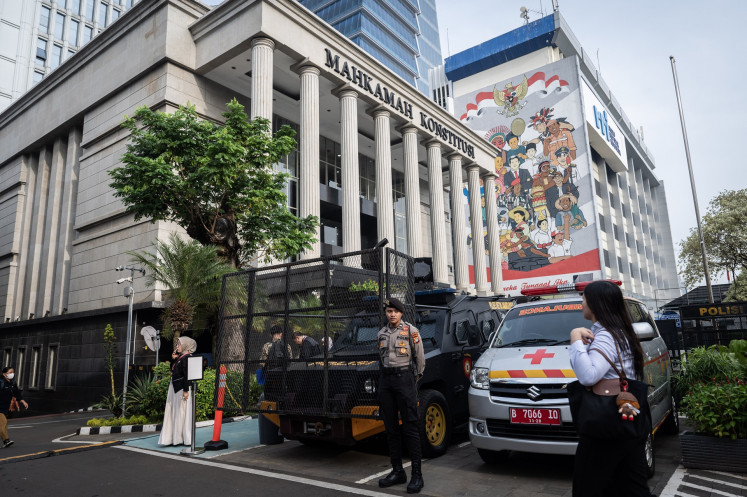Whither the development of Indonesian towns and cities?
Today we experience demographic urbanism in contraction and explosion
Change text size
Gift Premium Articles
to Anyone

T
oday we experience demographic urbanism in contraction and explosion. Most towns and cities on Java, especially Jakarta, suffer from and are overwhelmed by traffic jams, air pollution and a scarcity of affordable housing, sanitation and drinking water. The quality of life in urban areas in most big cities is alarming.
Speaking of a master plan is irrelevant. Plans have been always lagging behind what is actually happening. What the towns and cities need is not to plan in terms of rigid schemes, but to set forth a strategic framework for handling, structuring and managing their current situations. The goal is to improve the quality of living, working and playing in urban areas.
Accordingly, urbanism in Indonesia should have an urban vision based on local conditions and needs in dealing with the sustainable growth of populations, economic welfare, social justice, environmental bearing capacity, public health and safety.
The basic foundation of such a vision should be the locally rooted territory of demographic, socio-cultural and economic conditions.
In doing so, we are able to establish our country's determination for dealing with global markets and trade, global warming and other issues. In other words, the vision of urbanism in Indonesia should be developed with local resources, not from external pressures and demands.
The best plan is to have no rigid and definite plan, which usually does not work. However, master planning is only effective in terms of intuitive envisioning that enables us to manage development with a reliable framework. We speak of strategic envisioning in overcoming the daily business of urbanism with a workable vision.
The example for this is urbanism based on demographic, socio-cultural and economic sustainability. The keyword for this is urbanism based on the distribution of economic activities for livability with well-proportioned demographic figures and land use. In doing so, the concentration of daily activities is dispersed and disseminated among the public realms with walkable environments and a public transportation-friendly network.
Today, urban developers in Jakarta and other big cities are in favor of superblock and private development with economically gated commercial centers. This is a catastrophic approach and an anti-urban development for sustainable environment. Such an approach ignores the right of urban people for public realms that are supposed to be provided by the space between buildings on a human scale.
Why does such large-scale and superblock development happen in Indonesia? Among several reasons for this, two possible explanations stand out.
First, municipal governments are unable to manage huge investment from the private sector within a fair private-public partnership of urban development. Second, there is no political will from municipalities to work together for good urbanism; this is likely not about the logic of capitalism, but simply about cultural attitude and the mentality of people in power in terms of priyayi (aristocracy) or juragan (master). Municipalities do not care too much about the process, but more about the outcome of development for the city's revenues and for job creation.
In order to set forth an agenda of urbanism for the coming decades, Indonesian urban planners should be aware of at least three points.
First, the essence of urbanism does not lie in its form and production, but in the reality of being urban, meaning exercising highly developed manners and attitudes toward others in the sense of people, the environment and culture, which in the local language is called budi luhur.
Throughout the millennia, the objective of urban development on the globe is to achieve this cultural concept with fine architecture, arts, literature, science and technology. A surplus of economic production and population growth is not the goal of urbanism, but the means to achieve this state of affairs. Such an achievement will be shown on the streets and in public places involving how people interact with each other on a daily basis.
The most important indicators are how people drive their cars on the roads and what they do when they encounter each other, either through spoken language or gestures. The recent Asia-Pacific Forum on Urbanism on Oct. 19 in Jakarta pointed out the importance of urbanism as the keyword for urban development; urbanism privileges its position above infrastructure, housing and the economy.
All this is a sign that urban development is not about building skyscrapers, a million homes or thousands of kilometers of roads. Rather, urbanism is about building people as urban citizens with respect and dignity.
Planning and design are the tools and instruments to actualize urbanism as a real, well-integrated system of living, working and playing.
Second, all stakeholders and players involved in urban development in Indonesia should demolish their pride in and orientation toward the development models established and developed in industrialized countries. Our towns and cities have been developed without formal planning and design, but in response to the abruptly exploding need and growth of capitalist production and consumerism. The ultimate purpose of this urban development is to entertain and cater to individualistic indulgence and self-gratification.
Public social gatherings during the weekend Car Free Day is a phenomenon of urbanism resulting from a guilty feeling over the harsh and unfriendly competition on the streets on the weekdays. Needless to say, such public gatherings are a consequence of a decadently livable downtown because most people do not live there during the weekend.
Demographically, some districts in Central Jakarta in 2013 and 2014 showed the decline of the younger population with the increase of a working age population. The scarcity of open green spaces and children's playgrounds is not conducive for raising families with children. On the other hand, the growing number of rental housing units for professionals and skilled workers is obvious.
Intensification of land use and the diversity of its uses are necessarily managed and require the adjustment of current plans. Most current land uses ' as presented on the spatial plan (RDTR) ' are blindly enforced without flexible and possible adjustments in dealing with the value of land and market forces. Cities and towns need to establish a committee of adjustment in the municipal body to deal with current needs.
Third, urban codes and regulations in the Indonesian context are mostly only on paper. The actual executions of plans on the sites are different. The problem is not simply about law enforcement. Rather, codes and regulations should be made in alignment with the principles of urbanism that provide livable public realms based on safe, healthy and attractive pedestrian environments with access to public transportation.
These principles are likely unrealistic without strong commitment from all stakeholders and components of urban development. The most obvious crucial thing is the fact that the power relation of urban development in Indonesia is divided into only two poles: the regulator and the developer.
Business and professional associations, as well as citizen representatives, the media and community organizations, do not have legal power to participate in the development process and stewardship of the plans.
The law for spatial planning and development puts these stakeholders and components at a marginal and voluntarily position. In doing so, there is no check and balance mechanism in the urban development process. Collusive syndication between political authority and commercial power is unavoidable in the name of progress, growth and development of revenues and investments.
The three points should be worked out to establish a framework of urban development that concerns urbanism as its core and its area of concern, not simply sustainable development. We build towns and cities from and for the improvement of humanity, not simply for their needs and wants.
Accordingly, the principle of budi luhur should be the categorical principle that guides and stewards the vision and direction of urban development.
_________________________________
The writer is an independent scholar, architect and planner living and working in Toronto, Canada.









